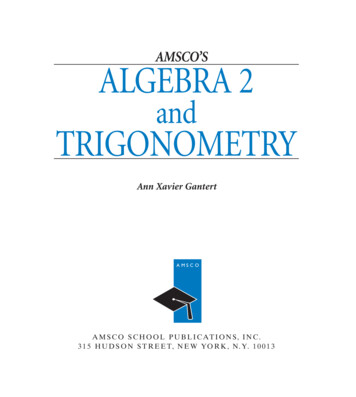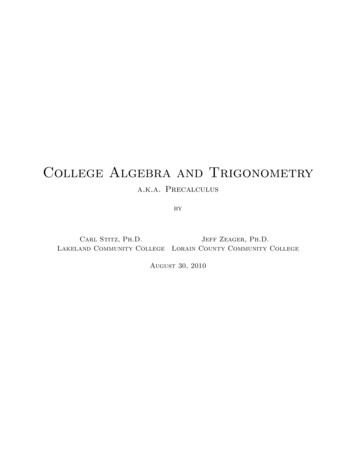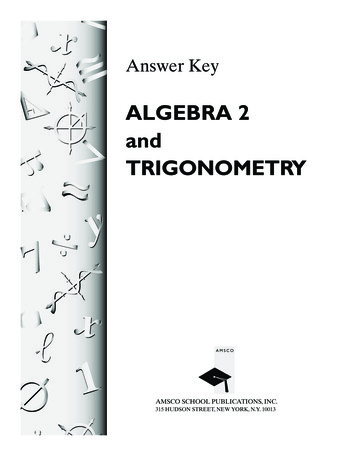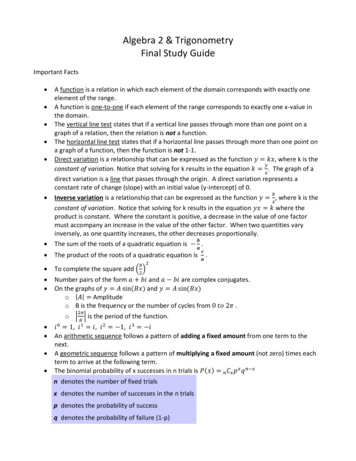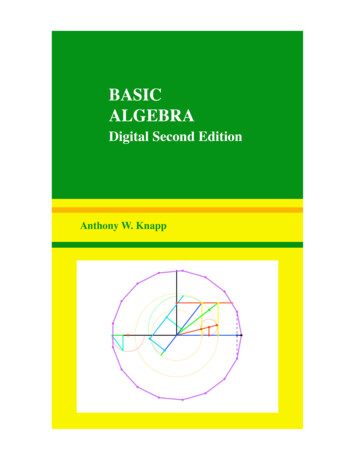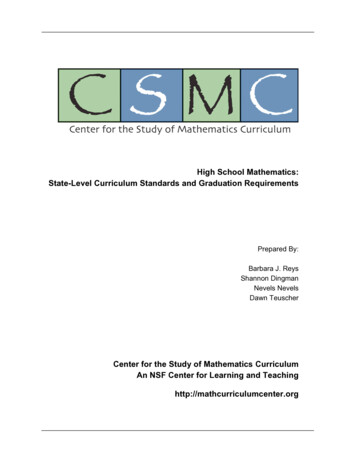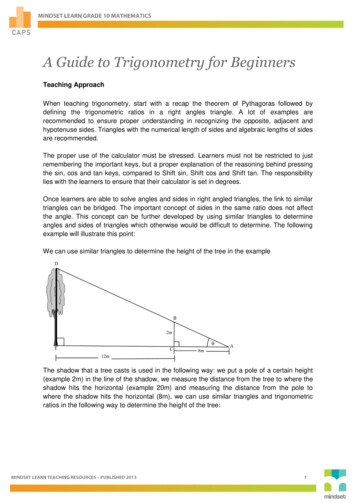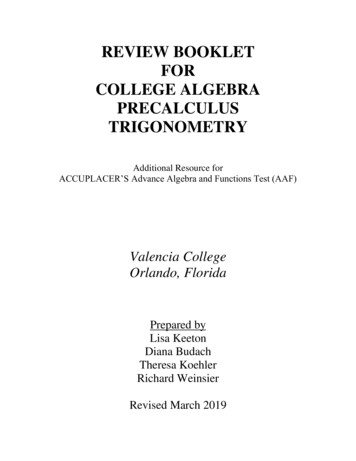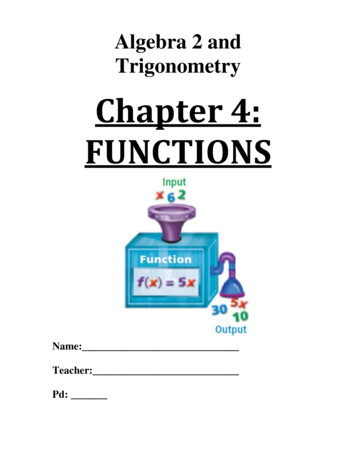
Transcription
Algebra 2 andTrigonometryChapter 4:FUNCTIONSName:Teacher:Pd:
Table of ContentsDay1: Chapter 4-1: Functions; Domain and RangeSWBAT: Identify the domain and range of relations and functionsPgs. #1 - 5Hw: pg 126 in textbook. #1 - 11Pg.133 in textbook #3 – 12Day2: Chapter 4-2: Function NotationSWBAT: Evaluate FunctionsPgs. #6 - 10HW: pg 129 in textbook. #3 – 15, 17Day3: Chapter 4: Functions with Restricted DomainsSWBAT: Calculate restricted domains of functionsPgs. #11 - 14Hw: Worksheet in Packet on Pages 15-16Day4: Chapter 4-4: Graphing Absolute Value FunctionsSWBAT: (1) Graph Absolute Value Functions(2) Translate Absolute Value FunctionsPgs. #17 – 23HW: Worksheet in Packet on Pages 24- 26Day5: Chapter 4-5/4-6: Transformations of Quadratic and Other functionsSWBAT: Transform Quadratic and Other functionsPgs. #27 – 31Hw: Worksheet in Packet on Pages 32-35Day6: Chapter 4-7: Composition of FunctionsSWBAT: Evaluate the composition of a functionPgs. #36 – 40Hw: Worksheet in Packet on Pages 41-42Day7: Chapter 4-8: Inverse FunctionsSWBAT: Find the Inverse of a FunctionPgs. #43 – 48Hw: Worksheet in Packet on Pages 49-50Day8: Chapter 4-10: Inverse VariationSWBAT: Solve Problems involving Inverse VariationPgs. #51 – 45Hw: Worksheet in Packet on Page 56HOMEWORK ANSWER KEYS – STARTS AT PAGE 57
Chapter 4–1 – Relations and Functions (Day 1)SWBAT: Identify the domain and range of relations and functionsA set of ordered pairs is called a . Ex: {() () () (} The domain of a relation is the set of all valuesThe range of a relation is the set of all values.Notation Use { } if the D/R has only a few values Use Set Notation otherwise{x -2}{y -1}1
For each relation below, state the domain and range.Example 1:Example 2:FunctionsA function is a relation where each x goes to only one y No x values are repeated among ordered pairs A graph would pass the Vertical Line Test Any vertical line only crosses graph once It is OK if the y‐values are repeated2
One-to-One FunctionsA one-to-one function (1-1) is function relation in which each member of therange also corresponds to one and only one member of the domain. No y values are repeated among ordered pairs A graph would pass the Horizontal Line TestFor each function below, determine if it is One-to-One.Example 3:Example 4:3
Am I a function? Am I One-to-One?If your answer to “Is it a function” or “is it a 1-1 function” is “no” explain why not.Domain a.b.TomLuisIrvinMarcEboneNinaRobynUnsha{(-1, 5), (2, 5), (2, 4), (-3, 1)}Range Function?1-1 Function?Domain Range Function?1-1 Function?c.Domain Range Function?1-1 Function?d.Domain Range Function?1-1 Function?e. y -(x 2)2 8Domain Range Function?1-1 Function?f. Domain Range Function?1-1 Function?4
SUMMARYExit Ticket5
Chapter 4–2 – FUNCTION Notation (Day 2)SWBAT:Evaluate FunctionsWarm – Up:Determine the domain and range of the relation below.Determine if the relation is a function and if it is a one-to-onefunction.Domain Range Function?1-1 Function?Function Notation x is an independent variable Y is the dependent variable because its valuedepends on the given x‐value Y f(x)– Means y is a function of x (dependant on x)– Read “f of x”– F is the name of the function– X is the independent variable6
If you want to evaluate a function at, for example, the x-value of 3,we write “determine ( ).” Simply substitute x in the equationand evaluate:Example: If ( )( ), find ( )( )( )Example 1: If f(x) 2x 3, finda. f(-4) b. f(a 1) c. f(2x) d. f(x2) Example 2: If f(x) x2 – 6, finda. f(2)b. fnd f(n - 2)c. find f(3x)d. If the domain of f(x) x2 – 6 is {x -2 x 2}, find the range of the function.7
Example 3: The graph of function f is shown below. Find:a. f(-1)b. f(0)c. f(1)d. f(3)Practice Section: Evaluating Functions1. If ( )3. If f(x) ,find (, find f(8)5. If f(x) x2 - 4x , find f(-2)).2. If f(x) , find f(6).4. If f(x) 4x - 5 , find f(-2)6. If g(x) 3x 4 and the domain is{x -1 x 7}, find the range.8
7.Answers:a.b.c.d.e.f.g.h.i.9
ChallengeSummary/ClosureExit Ticket:10
Chapter 4 – Functions with Restricted Domains(Day 3)SWBAT:Calculate restricted domains of functionsWarm – Up:Functions with Restricted DomainsAny equation that can be written as “y ” with no symbol is a function.Almost every any function we study this year has the domain “All RealNumbers” ( ) which means that you are allowed to use ANY VALUE OF Xyou want, and there will be some value of y that corresponds to it.Functions with Restricted Domains have some value(s) of x which cannotbe used, because it results in some undefined values of y.Functions that have no domain restriction:( )( )( ) 11
These are the three functions with restricted domains we will explore this year:Rational FunctionsSquare Root FunctionsA rational function is( )defined as ( ),( )A square root functionhas a square root in it!( ) ( )where ( ) and ( )are also functions of x.Example:( )try the value x 3.Rational Fractions areundefined when thedenominator 0Put the two together and you have arational function with a square root inthe denominator.Example: ( ) try the value x -10.Set the den. 0 andSolve. These are therestricted values.Example:( ) try the value x -4.Square Root functions areundefined when theradicand is 0( )( )To restrict the domain:Combination of the two (acomposition of a rationalfunction and a square rootfunction)These functions are undefinedwhen the radicand in thedenominator 0 To restrict the domain:Set the radicand 0.Solve. These are therestricted values.f ( x) 34x 8To restrict the domain:Set the denominator’sradicand 0. Solve. Theseare the restricted values.Determine the domain of each of the following rational functions:a) ( )b) ( )c) ( )12
Determine the domain of each of the following rational functions:e) ( )d) ( )f)( )Determine the domain of each of the following square root function:g) f ( x ) xh) f ( x ) x 3i) f ( x ) 2 x 6j)f ( x) 3 x 4 8k)( ) Determine the domain of each of the following compositions of square root and rational functionsl)f ( x) 34x 8m)( ) n)( ) 13
Summary/Closure:Type of Function ExampleDomainRangeLinearQuadraticAbsolute ValueSquare RootRationalFunctionComposition ofRationalFunction andSquare RootFunctionDo Not DetermineDo Not DetermineExit Ticket:14
Restricted Domain Homework – Day 3Work On Problems #5, 8, 10, 11, 13, 15 ,16-24 ,26, 28, 3315
16
GRAPHING ABSOLUTE VALUE FUNCTIONS (Day 4)SWBAT: Graph Absolute Value functionsWarm – Up:In Unit 2, we talked about absolute value in terms of the distance a number is away from zero on a number line.We will now investigate the graph of the absolute value function.Graph: VERTEXThe vertex of the absolute value function is the point where the function changes direction.Which coordinates are the turning points (vertex) of the graph above? ( , )17
Exercise #2: Graph the following functions using a graphing calculator.y y SUMMARYWhen y the graph is shiftedWhen y the graph is shifted18
Exercise #3: Consider the function: y and y (a) Using your graphing calculator to generate an xy-table, graph this function on thegiven grid.y y SUMMARYCompare the graphs for problem 4. Make a conjecture about functions that come in the form:y .When y When y the graph is shiftedthe graph is shifted19
A translation is a shift of a graph vertically, horizontally, or both. The resulting graph isthe same size and shape as the original but is in a different position in the plane.Practice: Writing equations of an absolute value finction from its graph.Write an equation for each translation of y shown below.a)b)c)d)e)f)20
Vertical and Horizontal TranslationsIdentify the vertex and graph each.g) y h) yVertex: ( , )i)y - 2Vertex: ( , ) Vertex: ( , )j) y 3Vertex: ( , )21
Lastly, let’s observe what happens when the coefficient changes in front ofthe absolute value of x.y y Compare the graphs from above. Make a conjecture about functions that come in the form:y When y the graph opensWhen y the graph is opens(which means its reflected over the axis)y y Compare the graphs from above. Make a conjecture about functions that come in the form:y When yWhen the graphis than the graphis thany .y .22
SUMMARY ; Vertex (h, k)Exit Ticket1.2.23
Homework – Writing and Graphing Functions – Day 44.24
In examples 5 – 13, write an equation for each translation of y 5.6.7.8.9.10.9 units up6 units downright 4 unitsleft 12 units8 units up, 10 units left3 units down, 5 units right 11.12.13.25
In examples 14 and 15, identify the vertex and graph each.14) y Vertex: ( , )16) On the set of axes below, graph and label theequations y y 2 .Explain how changing the coefficient of theabsolute value from 1 to 2 affects the graph.15) y - 7Vertex: ( , )17) On the set of axes below, graph and label theequations y y .Explain how changing the coefficient of theabsolute value from 1 to affects the graph26
Chapter 4–5/4-6 –TRANSFORMATION OF QUADRATICSAND OTHER FUNCTIONS (Day 5)SWBAT: Transform Quadratic and Other functionsWarm – Up:1.2. The vertex of y (1)(2)(3)(4) - 3 is(2, 3)(-2, 3)(-2, -3)(2, -3)27
Quadratic FunctionsA quadratic function is an equation in the form y ax2 bx c, where a, b, and c are real numbers anda0. The shape of a quadratic function is a , a smooth and symmetric U-shape.Example 4: Use the table of values below to graph the quadratic of basicfunctionVertexFormQuadraticAbsolute ValueCubicSquare Root ()Vertex: (h, k) Vertex: (h, k) ()Vertex: (h, k) Vertex: (h, k)28
Knowing how a function can be transformed makes it easier to graphthe function. There are three types of transformations that can be doneto a function.Functionf(x) cf(x) - cf(x c)f(x - c)f(-x)-f(x)( )a f(x)( )f(ax)TransformationDescribe the transformation for each function.FunctionTranformation ()2 7 29
Graphing Section: Graph each.1. y - 3. y (x 2)2 12. y 4. y 2x2 - 430
SUMMARYExit Ticket31
Day 5 – HWTransformation of Functionsa)( – )( )b)c)()32
() 33
34
35
Day 6: Chapter 4–7/Composition of FunctionsSWBAT: Add, Subtract, Multiply and Divide FunctionsWarm – Up:Operations on Functions Given 2 functions f and g:NotationMeans()( )( – )( )( )( )( )( )Domain of Functions First find domain of f and g The domain of , -, or * is the intersectionof the domains of f and g The domain of must exclude values thatmake denominator 0.36
Find:a) ()( )b) ()( )c) ()( )d) ( ) ( )1)Composition of FunctionsA composition of two or more functions is when a function is performed on the result of anotherevaluated function.)( ) both are readThere are two ways to represent the composition of a function: ( ( )) or (“f of g of x”, and mean that you are taking the result of g(x) and applying that result to the function f.Example: f(x) x 2 and g(x) 5x – 4. Find f(g(3)).F(g(3)) means determine g(3), then find f(result).gf3 5(3) – 4 11 (11) 2 13(f g)(3)So, f(g(3)) 13. This is also (f g)(3).Composition of functions is generally not commutative, meaning the order matters!37
Given: f(x) 3x – 2Determine:1. (g f)(-3)4. (h g)(-6)g(x) x2 1h(x) x 3j(x) (x 2)22. (f g)(-3)3. (g h)(4)5. (f h g)(2)6. (g h f)(1)Finding a general formula for f(g(x)) or g(f(x)) requires you to go the same thing without actualvalues of x.Example: f(x) x 2 and g(x) 5x – 4. Find f(g(x)) and g(f(x)).f(g(x)) means do g(x) first, then do f(result). f( g(x) ) f(5x – 4) (5x – 4) 2 5x – 4 2 5x – 2.So, f(g(x)) 5x – 2 g( f(x) ) g( x 2 ) 5(x 2) – 4 5x 10 – 4So, g(f(x)) 5x 638
Given: f(x) 3x – 2g(x) x2 1Determine the general formulas for:7. (f g)(x)8. (g f)(x)10. (h g)(x)11. (f h)(x)h(x) x 3j(x) (x 2)29. (g h)(x)12. (h f)(x)39
SummaryExit Ticket40
Day 6: HWWork on Problems #2-42 Every Other Even41
42
Day 7: Chapter 4–8/Inverse FunctionWarm – Up1.2.Inverse FunctionThe inverse of a function is found by switching the x and y values.Example:Function f:126387Function f {(1, 6), (2, 7), (3, 8)}This function is said to be one-to-one since no two ordered pairs have the same second element.We already know that the x values cannot repeat. In a one-to-one function, no y value willrepeat either.A function has an inverse function if and only if it is a one-to-one function.If we switch the domain and range, we notice that the relation is still a function, since noelements of the domain repeat.678123-1Inverse function f {(6, 1), (7, 2), (8, 3)}Because the original function is one-to-one, the inverse will also be a function.43
There are 3 ways to find the inverse of a function: Ordered Pairs Coordinate Graph Algebraically1. Ordered PairsExample 1:Given f(x) {(3, 7), (5, 1), (7, 1)}, find the inverse.Is the inverse a function? Explain your reasoning.2. Coordinate PlaneIn Geometry last year, you learned that (x, y) (y, x) is a reflection in the line y x.The inverse of a composition of a 1-1 function f is graphed by reflecting the function f inthe line y x, that is, the line whose equation is the identity function i.Example 2:44
3. AlgebraicallyThe rule of the inverse function f-1 can be found by interchanging x andy in the rule of the given function f.Example 3: Find f-1(x) if f(x) 2x 31. Rewrite f(x) 2x 3 as a y 2x 32. Switch x and y3. Solve for yPractice Section:Find the inverse of each function.1.2.( ) 45
Practice Section:Find the inverse of each function.3.( ) 4.( ) -1(a)Using the same axes, sketch the graph of f .(b) State the domain and range of f.(c) State the domain and range of f-1.5.6.46
Regents Questions47
ChallengeSummaryExit Ticket48
Day 7 Homework: Inverse FunctionEvens Only!49
50
Day 8: Inverse VariationWarm - UpIn Algebra, you learned about Direct Variations.Direct variation: the ratio of 2 variables is a constant. We say the variables are directlyproportional or that they vary directly. It is of the formorAll direct variations are linear functions that intersect the origin. They are always one toone.51
Inverse variation: the product of 2 variables is a constant. We say the variables areinversely proportional or that they vary inversely. It is of the form.We use this equation to solve problems:The graph of an inverse variation function is a hyperbola, a two-branched curvedshape.The graph of an inverse variation function is a hyperbola, a two-branched curvedshape.k 0k 0Asymptote- An asymptote is a line in which a graph gets infinitelyclose to but never touches. In inverse variation graphs, theasymptotes are the axes.52
The HyperbolaExample 1: Graph xy 4Example 2: Graph y Example 3: Write the equation of the hyperbola below.53
Example 4: The speed of a laundry truck varies inversely with thetime it takes to reach its destination. If the truck takes 3 hours toreach its destination traveling at a constant speed of 50 miles perhour, how long will it take to reach the same location when it travelsat a constant speed of 60 miles per hour?Example 5: The time it takes to travel a fixed distance varies inverselywith the speed traveled. If it takes Pam 40 minutes to bike to thesecret fishing spot at 9 miles per hour, what is the equation thatrepresents this situation? How long will it take if she rides 12 milesper hour?Example 6: The volume V of a gas kept at a constant temperaturevaries inversely as the pressure p. If the pressure is 24 pounds persquare inch, the volume is 15 cubic feet. What will be the volumewhen the pressure is 30 pounds per square inch?54
ChallengeTo build a sound wall along the highway, the amount of time t needed varies directlywith the number of cement blocks c needed and inversely with the number of workersw. A sound wall made of 2400 blocks, using six workers takes 18 hours to complete.How long would it take to build a wall of 4500 blocks with 10 workers?SUMMARYExit Ticket55
Day 8 Homework: Inverse VariationWork on Odds Only!56
HOMEWORK ANSWER KEY57
Day 3 - HW Answers for Pages 15 – 16 in Packet58
59
60
61
62
63
64
65
HW Answers for Day 666
HW Answers for Day 767
Answers to Day 868
A quadratic function is an equation in the form y ax2 bx c, where a, b, and c are real numbers and a 0. The shape of a quadratic function is a _, a smooth and symmetric U-shape. Example 4: Use the table of values below to graph the quadratic function. x y -1 -1 0 -4 1

